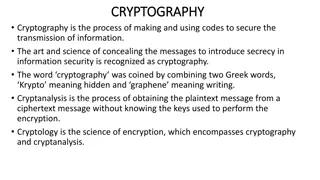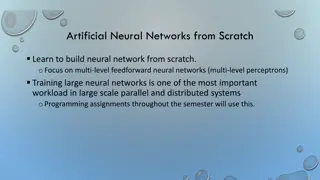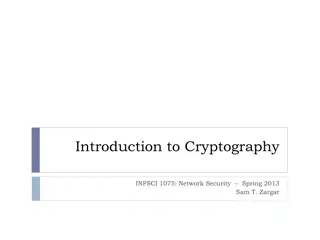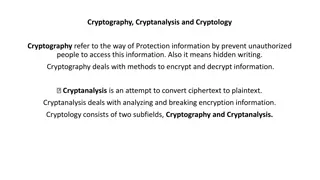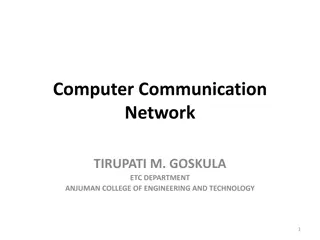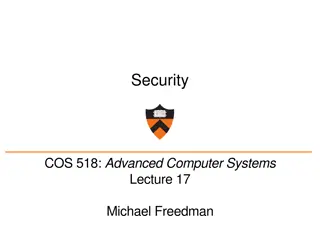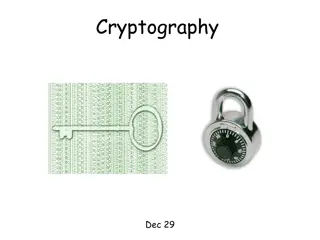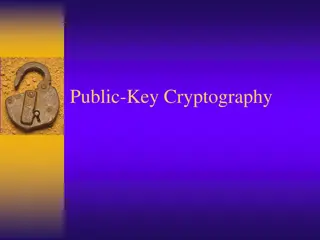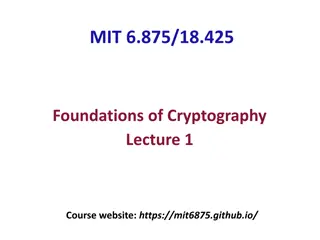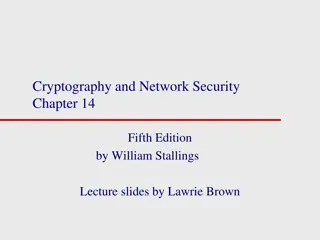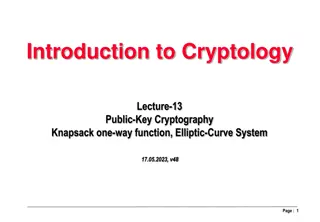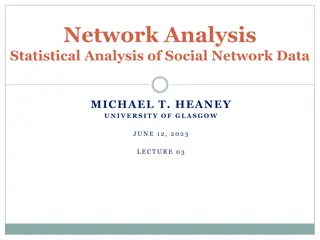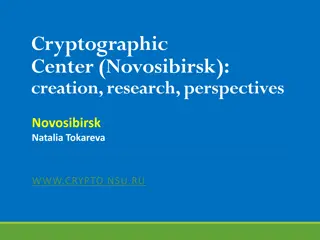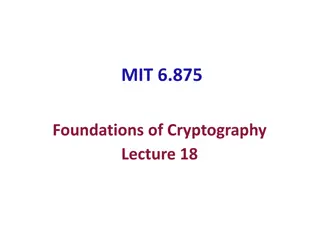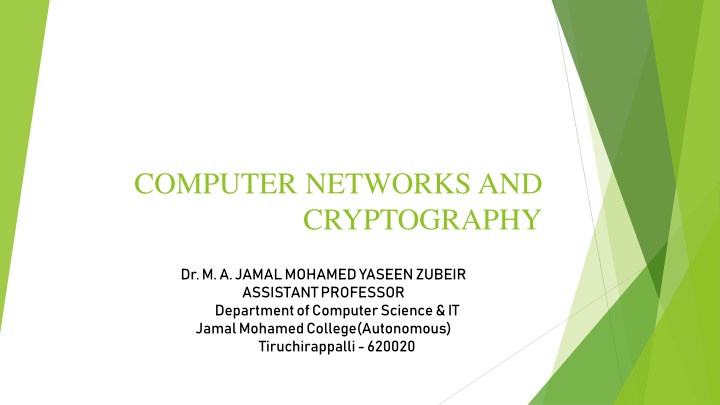
Computer Networks and Cryptography: Understanding Data Communication
"Explore the fundamentals of computer networks, data communication, and cryptography with Dr. M. A. Jamal Mohamed Yaseen Zubeir. Learn about network topology, internet basics, and the importance of learning data communication in the field of computer science and IT."
Download Presentation

Please find below an Image/Link to download the presentation.
The content on the website is provided AS IS for your information and personal use only. It may not be sold, licensed, or shared on other websites without obtaining consent from the author. If you encounter any issues during the download, it is possible that the publisher has removed the file from their server.
You are allowed to download the files provided on this website for personal or commercial use, subject to the condition that they are used lawfully. All files are the property of their respective owners.
The content on the website is provided AS IS for your information and personal use only. It may not be sold, licensed, or shared on other websites without obtaining consent from the author.
E N D
Presentation Transcript
COMPUTER NETWORKS AND CRYPTOGRAPHY Dr. M. A. JAMAL MOHAMED YASEEN ZUBEIR ASSISTANT PROFESSOR Department of Computer Science & IT Jamal Mohamed College(Autonomous) Tiruchirappalli - 620020
Introduction - Network Computer Network: An interconnection of multiple devices, also known as hosts, that are connected using multiple paths for the purpose of sending/receiving data or media. Computer networks can also include multiple devices/mediums which help in the communication between two different devices; these are known as Network devices and include things such as routers, switches, hubs, and bridges.
What is a Computer Network? A computer network is a group of two or more interconnected computer systems. You can establish a network connection using either cable or wireless media. Every network involves hardware and software that connects computers and tools.
Network Topology: The layout arrangement of the different devices in a network. Common examples include: Bus, Star, Mesh, Ring, and Daisy chain.
Data Communication Data communications refers to the transmission of this digital data between two or more computers and a computer network or data network is a telecommunications network that allows computers to exchange data. The physical connection between networked computing devices is established using either cable media or wireless media. The best-known computer network is the Internet. The basics of Data Communication and Computer Network (DCN) and will also take you through various advance concepts related to Data Communication and Computer Network.
Why to Learn Data Communication & Computer Network? Network Basic Understanding A system of interconnected computers and computerized peripherals such as printers is called computer network. This interconnection among computers facilitates information sharing among them. Computers may connect to each other by either wired or wireless media. Network Engineering Networking engineering is a complicated task, which involves software, firmware, chip level engineering, hardware, and electric pulses. To ease network engineering, the whole networking concept is divided into multiple layers. Each layer is involved in some particular task and is independent of all other layers. But as a whole, almost all networking tasks depend on all of these layers. Layers share data between them and they depend on each other only to take input and send output.
Internet A network of networks is called an internetwork, or simply the internet. It is the largest network in existence on this planet. The internet hugely connects all WANs and it can have connection to LANs and Home networks. Internet uses TCP/IP protocol suite and uses IP as its addressing protocol. Present day, Internet is widely implemented using IPv4. Because of shortage of address spaces, it is gradually migrating from IPv4 to IPv6. Internet enables its users to share and access enormous amount of information worldwide. It uses WWW, FTP, email services, audio and video streaming etc. At huge level, internet works on Client- Server model. Internet uses very high speed backbone of fiber optics. To inter- connect various continents, fibers are laid under sea known to us as submarine communication cable.
Applications of Communication & Computer Network Computer systems and peripherals are connected to form a network. They provide numerous advantages: Resource sharing such as printers and storage devices Exchange of information by means of e-Mails and FTP Information sharing by using Web or Internet Interaction with other users using dynamic web pages IP phones Video conferences Parallel computing Instant messaging
Network Models A communication subsystem is a complex piece of Hardware and software. Early attempts for implementing the software for such subsystems were based on a single, complex, unstructured program with many interacting components. The resultant software was very difficult to test and modify. To overcome such problem, the ISO has developed a layered approach. In a layered approach, networking concept is divided into several layers, and each layer is assigned a particular task. Therefore, we can say that networking tasks depend upon the layers.
OSI Model OSI stands for Open System Interconnection is a reference model that describes how information from a software application in one computer moves through a physical medium to the software application in another computer. OSI consists of seven layers, and each layer performs a particular network function. OSI model was developed by the International Organization for Standardization (ISO) in 1984, and it is now considered as an architectural model for the inter-computer communications. OSI model divides the whole task into seven smaller and manageable tasks. Each layer is assigned a particular task. Each layer is self-contained, so that task assigned to each layer can be performed independently.
The OSI model is divided into two layers: upper layers and lower layers. The upper layer of the OSI model mainly deals with the application related issues, and they are implemented only in the software. The application layer is closest to the end user. Both the end user and the application layer interact with the software applications. An upper layer refers to the layer just above another layer. The lower layer of the OSI model deals with the data transport issues. The data link layer and the physical layer are implemented in hardware and software. The physical layer is the lowest layer of the OSI model and is closest to the physical medium. The physical layer is mainly responsible for placing the information on the physical medium.
Functions of the OSI Layers There are the seven OSI layers. Each layer has different functions. A list of seven layers are given below: 1. Physical Layer 2. Data-Link Layer 3. Network Layer 4. Transport Layer 5. Session Layer 6. Presentation Layer 7. Application Layer
Physical layer The main functionality of the physical layer is to transmit the individual bits from one node to another node. It is the lowest layer of the OSI model. It establishes, maintains and deactivates the physical connection. It specifies the mechanical, electrical and procedural network interface specifications.
Functions of a Physical layer: Line Configuration: It defines the way how two or more devices can be connected physically. Data Transmission: It defines the transmission mode whether it is simplex, half-duplex or full-duplex mode between the two devices on the network. Topology: It defines the way how network devices are arranged. Signals: It determines the type of the signal used for transmitting the information.
Data-Link Layer This layer is responsible for the error-free transfer of data frames. It defines the format of the data on the network. It provides a reliable and efficient communication between two or more devices. It is mainly responsible for the unique identification of each device that resides on a local network.
It contains two sub-layers: Logical Link Control Layer It is responsible for transferring the packets to the Network layer of the receiver that is receiving. It identifies the address of the network layer protocol from the header. It also provides flow control. Media Access Control Layer A Media access control layer is a link between the Logical Link Control layer and the network's physical layer. It is used for transferring the packets over the network.
Functions of the Data-link layer Framing: The data link layer translates the physical's raw bit stream into packets known as Frames. The Data link layer adds the header and trailer to the frame. The header which is added to the frame contains the hardware destination and source address. Physical Addressing: The Data link layer adds a header to the frame that contains a destination address. The frame is transmitted to the destination address mentioned in the header. Flow Control: Flow control is the main functionality of the Data-link layer. It is the technique through which the constant data rate is maintained on both the sides so that no data get corrupted. It ensures that the transmitting station such as a server with higher processing speed does not exceed the receiving station, with lower processing speed. Error Control: Error control is achieved by adding a calculated value CRC (Cyclic Redundancy Check) that is placed to the Data link layer's trailer which is added to the message frame before it is sent to the physical layer. If any error seems to occurr, then the receiver sends the acknowledgment for the retransmission of the corrupted frames. Access Control: When two or more devices are connected to the same communication channel, then the data link layer protocols are used to determine which device has control over the link at a given time.
Network Layer It is a layer 3 that manages device addressing, tracks the location of devices on the network. It determines the best path to move data from source to the destination based on the network conditions, the priority of service, and other factors. The Data link layer is responsible for routing and forwarding the packets. Routers are the layer 3 devices, they are specified in this layer and used to provide the routing services within an internetwork. The protocols used to route the network traffic are known as Network layer protocols. Examples of protocols are IP and Ipv6.
Functions of Network Layer: Internetworking:An internetworking is the main responsibility of the network layer. It provides a logical connection between different devices. Addressing:A Network layer adds the source and destination address to the header of the frame. Addressing is used to identify the device on the internet. Routing: Routing is the major component of the network layer, and it determines the best optimal path out of the multiple paths from source to the destination. Packetizing:A Network Layer receives the packets from the upper layer and converts them into packets. This process is known as Packetizing. It is achieved by internet protocol (IP).
Transport Layer The Transport layer is a Layer 4 ensures that messages are transmitted in the order in which they are sent and there is no duplication of data. The main responsibility of the transport layer is to transfer the data completely. It receives the data from the upper layer and converts them into smaller units known as segments. This layer can be termed as an end-to-end layer as it provides a point-to-point connection between source and destination to deliver the data reliably.
The two protocols used in this layer are: Transmission Control Protocol It is a standard protocol that allows the systems to communicate over the internet. It establishes and maintains a connection between hosts. When data is sent over the TCP connection, then the TCP protocol divides the data into smaller units known as segments. Each segment travels over the internet using multiple routes, and they arrive in different orders at the destination. The transmission control protocol reorders the packets in the correct order at the receiving end. User Datagram Protocol User Datagram Protocol is a transport layer protocol. It is an unreliable transport protocol as in this case receiver does not send any acknowledgment when the packet is received, the sender does not wait for any acknowledgment. Therefore, this makes a protocol unreliable.
Functions of Transport Layer: Service-point addressing: Computers run several programs simultaneously due to this reason, the transmission of data from source to the destination not only from one computer to another computer but also from one process to another process. The transport layer adds the header that contains the address known as a service-point address or port address. The responsibility of the network layer is to transmit the data from one computer to another computer and the responsibility of the transport layer is to transmit the message to the correct process. Segmentation and reassembly: When the transport layer receives the message from the upper layer, it divides the message into multiple segments, and each segment is assigned with a sequence number that uniquely identifies each segment. When the message has arrived at the destination, then the transport layer reassembles the message based on their sequence numbers. Connection control: Transport layer provides two services Connection-oriented service and connectionless service. A connectionless service treats each segment as an individual packet, and they all travel in different routes to reach the destination. A connection-oriented service makes a connection with the transport layer at the destination machine before delivering the packets. In connection-oriented service, all the packets travel in the single route. Flow control: The transport layer also responsible for flow control but it is performed end-to-end rather than across a single link.
Session Layer It is a layer 3 in the OSI model. The Session layer is used to establish, maintain and synchronizes the interaction between communicating devices.
Functions of Session layer: Dialog control: Session layer acts as a dialog controller that creates a dialog between two processes or we can say that it allows the communication between two processes which can be either half-duplex or full-duplex. Synchronization: Session layer adds some checkpoints when transmitting the data in a sequence. If some error occurs in the middle of the transmission of data, then the transmission will take place again from the checkpoint. This process is known as Synchronization and recovery.
Presentation Layer A Presentation layer is mainly concerned with the syntax and semantics of the information exchanged between the two systems. It acts as a data translator for a network. This layer is a part of the operating system that converts the data from one presentation format to another format. The Presentation layer is also known as the syntax layer.
Functions of Presentation layer: Translation: The processes in two systems exchange the information in the form of character strings, numbers and so on. Different computers use different encoding methods, the presentation layer handles the interoperability between the different encoding methods. It converts the data from sender-dependent format into a common format and changes the common format into receiver- dependent format at the receiving end. Encryption: Encryption is needed to maintain privacy. Encryption is a process of converting the sender-transmitted information into another form and sends the resulting message over the network. Compression: Data compression is a process of compressing the data, i.e., it reduces the number of bits to be transmitted. Data compression is very important in multimedia such as text, audio, video.
Application Layer An application layer serves as a window for users and application processes to access network service. It handles issues such as network transparency, resource allocation, etc. An application layer is not an application, but it performs the application layer functions. This layer provides the network services to the end-users.
Functions of Application layer: File transfer, access, and management (FTAM): An application layer allows a user to access the files in a remote computer, to retrieve the files from a computer and to manage the files in a remote computer. Mail services:An application layer provides the facility for email forwarding and storage. Directory services: An application provides the distributed database sources and is used to provide that global information about various objects.
TCP/IP model The TCP/IP model was developed prior to the OSI model. The TCP/IP model is not exactly similar to the OSI model. The TCP/IP model consists of five layers: the application layer, transport layer, network layer, data link layer and physical layer. The first four layers provide physical standards, network interface, internetworking, and transport functions that correspond to the first four layers of the OSI model and these four layers are represented in TCP/IP model by a single layer called the application layer. TCP/IP is a hierarchical protocol made up of interactive modules, and each of them provides specific functionality. Here, hierarchical means that each upper-layer protocol is supported by two or more lower-level protocols.
Network Access Layer A network layer is the lowest layer of the TCP/IP model. A network layer is the combination of the Physical layer and Data Link layer defined in the OSI reference model. It defines how the data should be sent physically through the network. This layer is mainly responsible for the transmission of the data between two devices on the same network. The functions carried out by this layer are encapsulating the IP datagram into frames transmitted by the network and mapping of IP addresses into physical addresses. The protocols used by this layer are ethernet, token ring, FDDI, X.25, frame relay.
Internet Layer An internet layer is the second layer of the TCP/IP model. An internet layer is also known as the network layer. The main responsibility of the internet layer is to send the packets from any network, and they arrive at the destination irrespective of the route they take. Following are the protocols used in this layer are: IP Protocol: IP protocol is used in this layer, and it is the most significant part of the entire TCP/IP suite. Following are the responsibilities of this protocol:
IP Addressing: This protocol implements logical host addresses known as IP addresses. The IP addresses are used by the internet and higher layers to identify the device and to provide internetwork routing. Host-to-host communication: It determines the path through which the data is to be transmitted. Data Encapsulation and Formatting:An IP protocol accepts the data from the transport layer protocol. An IP protocol ensures that the data is sent and received securely, it encapsulates the data into message known as IP datagram. Fragmentation and Reassembly: The limit imposed on the size of the IP datagram by data link layer protocol is known as Maximum Transmission unit (MTU). If the size of IP datagram is greater than the MTU unit, then the IP protocol splits the datagram into smaller units so that they can travel over the local network. Fragmentation can be done by the sender or intermediate router. At the receiver side, all the fragments are reassembled to form an original message. Routing: When IP datagram is sent over the same local network such as LAN, MAN, WAN, it is known as direct delivery. When source and destination are on the distant network, then the IP datagram is sent indirectly. This can be accomplished by routing the IP datagram through various devices such as routers.
Transport Layer The transport layer is responsible for the reliability, flow control, and correction of data which is being sent over the network. The two protocols used in the transport layer are User Datagram protocol and Transmission control protocol. User Datagram Protocol (UDP) It provides connectionless service and end-to-end delivery of transmission. It is an unreliable protocol as it discovers the errors but not specify the error. User Datagram Protocol discovers the error, and ICMP protocol reports the error to the sender that user datagram has been damaged. UDP consists of the following fields: Source port address: The source port address is the address of the application program that has created the message. Destination port address: The destination port address is the address of the application program that receives the message. Total length: It defines the total number of bytes of the user datagram in bytes. Checksum: The checksum is a 16-bit field used in error detection. UDP does not specify which packet is lost. UDP contains only checksum; it does not contain any ID of a data segment.
Transmission Control Protocol (TCP) It provides a full transport layer services to applications. It creates a virtual circuit between the sender and receiver, and it is active for the duration of the transmission. TCP is a reliable protocol as it detects the error and retransmits the damaged frames. Therefore, it ensures all the segments must be received and acknowledged before the transmission is considered to be completed and a virtual circuit is discarded. At the sending end, TCP divides the whole message into smaller units known as segment, and each segment contains a sequence number which is required for reordering the frames to form an original message. At the receiving end, TCP collects all the segments and reorders them based on sequence numbers.
Application Layer An application layer is the topmost layer in the TCP/IP model. It is responsible for handling high-level protocols, issues of representation. This layer allows the user to interact with the application. When one application layer protocol wants to communicate with another application layer, it forwards its data to the transport layer. There is an ambiguity occurs in the application layer. Every application cannot be placed inside the application layer except those who interact with the communication system. For example: text editor cannot be considered in application layer while web browser using HTTP protocol to interact with the network where HTTP protocol is an application layer protocol.
Following are the main protocols used in the application layer: HTTP: HTTP stands for Hypertext transfer protocol. This protocol allows us to access the data over the world wide web. It transfers the data in the form of plain text, audio, video. It is known as a Hypertext transfer protocol as it has the efficiency to use in a hypertext environment where there are rapid jumps from one document to another. SNMP: SNMP stands for Simple Network Management Protocol. It is a framework used for managing the devices on the internet by using the TCP/IP protocol suite. SMTP: SMTP stands for Simple mail transfer protocol. The TCP/IP protocol that supports the e-mail is known as a Simple mail transfer protocol. This protocol is used to send the data to another e-mail address. DNS: DNS stands for Domain Name System. An IP address is used to identify the connection of a host to the internet uniquely. But, people prefer to use the names instead of addresses. Therefore, the system that maps the name to the address is known as Domain Name System. TELNET: It is an abbreviation for Terminal Network. It establishes the connection between the local computer and remote computer in such a way that the local terminal appears to be a terminal at the remote system. FTP: FTP stands for File Transfer Protocol. FTP is a standard internet protocol used for transmitting the files from one computer to another computer.
Multiplexing (Channel Sharing) in Computer Network Multiplexing is a technique by which different analog and digital streams of transmission can be simultaneously processed over a shared link. Multiplexing divides the high capacity medium into low capacity logical medium which is then shared by different streams. Communication is possible over the air (radio frequency), using a physical media (cable), and light (optical fiber). All mediums are capable of multiplexing. When multiple senders try to send over a single medium, a device called Multiplexer divides the physical channel and allocates one to each. On the other end of communication, a De-multiplexer receives data from a single medium, identifies each, and sends to different receivers.
Frequency Division Multiplexing When the carrier is frequency, FDM is used. FDM is an analog technology. FDM divides the spectrum or carrier bandwidth in logical channels and allocates one user to each channel. Each user can use the channel frequency independently and has exclusive access of it. All channels are divided in such a way that they do not overlap with each other. Channels are separated by guard bands. Guard band is a frequency which is not used by either channel.
Time Division Multiplexing TDM is applied primarily on digital signals but can be applied on analog signals as well. In TDM the shared channel is divided among its user by means of time slot. Each user can transmit data within the provided time slot only. Digital signals are divided in frames, equivalent to time slot i.e. frame of an optimal size which can be transmitted in given time slot. TDM works in synchronized mode. Both ends, i.e. Multiplexer and De-multiplexer are timely synchronized and both switch to next channel simultaneously.
Wavelength Division Multiplexing Light has different wavelength (colors). In fiber optic mode, multiple optical carrier signals are multiplexed into an optical fiber by using different wavelengths. This is an analog multiplexing technique and is done conceptually in the same manner as FDM but uses light as signals. Further, on each wavelength time division multiplexing can be incorporated to accommodate more data signals.
Code Division Multiplexing Multiple data signals can be transmitted over a single frequency by using Code Division Multiplexing. FDM divides the frequency in smaller channels but CDM allows its users to full bandwidth and transmit signals all the time using a unique code. CDM uses orthogonal codes to spread signals. Each station is assigned with a unique code, called chip. Signals travel with these codes independently, inside the whole bandwidth. The receiver knows in advance the chip code signal it has to receive.
Transmission media What is Transmission media? Transmission media is a communication channel that carries the information from the sender to the receiver. Data is transmitted through the electromagnetic signals. The main functionality of the transmission media is to carry the information in the form of bits through LAN(Local Area Network). It is a physical path between transmitter and receiver in data communication. In a copper-based network, the bits in the form of electrical signals. In a fibre based network, the bits in the form of light pulses. In OSI(Open System Interconnection) phase, transmission media supports the Layer 1. Therefore, it is considered to be as a Layer 1 component. The electrical signals can be sent through the copper wire, fibre optics, atmosphere, water, and vacuum. The characteristics and quality of data transmission are determined by the characteristics of medium and signal. Transmission media is of two types are wired media and wireless media. In wired media, medium characteristics are more important whereas, in wireless media, signal characteristics are more important. Different transmission media have different properties such as bandwidth, delay, cost and ease of installation and maintenance. The transmission media is available in the lowest layer of the OSI reference model, i.e., Physical layer.
Some factors need to be considered for designing the transmission media: Bandwidth: All the factors are remaining constant, the greater the bandwidth of a medium, the higher the data transmission rate of a signal. Transmission impairment: When the received signal is not identical to the transmitted one due to the transmission impairment. The quality of the signals will get destroyed due to transmission impairment. Interference:An interference is defined as the process of disrupting a signal when it travels over a communication medium on the addition of some unwanted signal.
Causes Of Transmission Impairment: Attenuation:Attenuation means the loss of energy, i.e., the strength of the signal decreases with increasing the distance which causes the loss of energy. Distortion: Distortion occurs when there is a change in the shape of the signal. This type of distortion is examined from different signals having different frequencies. Each frequency component has its own propagation speed, so they reach at a different time which leads to the delay distortion. Noise: When data is travelled over a transmission medium, some unwanted signal is added to it which creates the noise.
Guided Media It is defined as the physical medium through which the signals are transmitted. It is also known as Bounded media. Types Of Guided media: Twisted pair: Coaxial Cable Fibre Optic
Twisted pair: Twisted pair is a physical media made up of a pair of cables twisted with each other. A twisted pair cable is cheap as compared to other transmission media. Installation of the twisted pair cable is easy, and it is a lightweight cable. The frequency range for twisted pair cable is from 0 to 3.5KHz. A twisted pair consists of two insulated copper wires arranged in a regular spiral pattern. The degree of reduction in noise interference is determined by the number of turns per foot. Increasing the number of turns per foot decreases noise interference.


